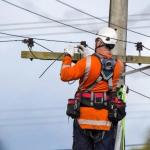How ‘Energy Democracy’ Could Build the Grid of the Future

On Nov. 7, Maine voters considered a referendum that would shift ownership of the state’s electric grid from foreign investors to local consumers. The proposal was soundly defeated, but it wasn’t a fair fight.
The grass-roots group that put the referendum forward was vastly outspent by Maine’s two investor-owned utilities. The grass-roots campaign had a budget of just $300,000 to educate the public on the benefits of a locally owned grid; the utilities spent close to $40 million to defeat the measure.
What the Maine campaign sought to achieve was a measure of “energy democracy,” a term emerging over the last several years. Its advocates want more say in how our electric grids are managed, what investments are a priority and how customers are treated. But given the deep pockets and political power of investor-owned utilities, this transition will be difficult.
It hasn’t always been this way. When most of the grid was built between the 1930s and the 1960s, it was owned by either municipalities or local private companies. In both cases, executives and managers were trusted members of the local community. They were accountable. And they were seen as heroes for bringing electric power to the rest of us.
Corporate takeovers during the 1980s and ’90s changed that. The thinking at the time was that corporate investors would bring more capital to invest in the grid. Based on this, public utility commissions didn’t hesitate to permit the sale of much of the grid to national and international corporations.
But in selling off the grid, they were making a big trade-off: Distant executives would no longer be accessible or accountable to local communities. Instead, they are accountable primarily to their corporate shareholders.
As a result, we’ve seen more power outages and rate hikes. We’ve seen major investments in profitable transmission lines, but little investment in updating and strengthening the grid to accommodate renewable energy. We’ve seen a decline in customer service. This is where we are today in most U.S. communities.
Energy democracy changes the status quo by embracing several principles:
- Public or collective ownership of energy infrastructure.
- Decentralization and strengthening of the grid to accommodate renewable energy.
- More public participation in policy and management decisions.
- Equitable governance of energy systems, taking into account race, geography and socioeconomic status.
Democratically run electric grids do exist today. This is because a number of electric grids across the country were never sold to corporate investors.
More than 2,000 U.S. communities get their power from a locally owned and managed utility. These utilities serve large cities including Austin, Nashville, Sacramento and Seattle. All of the state of Nebraska and many smaller towns and regions across the country also get their power from locally owned utilities. All told, 1 in 7 Americans receive their electricity from a locally owned grid.
The track record of locally owned grids is positive. They have consistently lower rates than investor-owned utilities. They are more reliable. And they have adopted renewable energy at a faster rate than the investor-owned utilities.
Today, climate action plans in towns, cities and states across the country call for clean energy fueled by wind, solar and hydro. Many of these plans also call for decarbonization and “beneficial electrification” — reducing the use of fossil fuels and electrifying transportation, businesses, and heating and cooling.
If all these things are electrified, the demand for electricity will greatly increase. To achieve local and state climate action goals, electric grids will need a significant upgrade. Increasing renewable energy means building new local transmission lines and upgrading circuits, switches and substations.
Locally and regionally owned utilities are in the best position to make the needed investments. Because their mission is to serve ratepayers, they can build what communities most want and need. And most can borrow through low-interest municipal bonds, making grid improvements affordable.
In contrast, investor-owned utilities operate in a regulatory system that incentivizes building large assets like centralized transmission lines. Meeting state and local climate action goals is not their priority; in many cases, meeting those goals is an added expense, reducing their bottom line.
The cost of capital is much higher for investor-owned utilities than for locally owned utilities. The difference in cost between municipal bonds at 3-5 percent interest and the combined debt and return on equity for investor-owned utilities of 8-12 percent amounts to billions of dollars in potential savings for ratepayers.
Several jurisdictions and regions have succeeded in taking back their electric grid from investor-owned utilities, notably Winter Park, Fla., and Long Island, N.Y. These efforts were long and costly. But the end results have been positive: Electric rates and power outages have been reduced.
Should our electric utilities be owned by distant shareholders? Should foreign entities make a profit on local electricity? Or should the electric grid be considered a part of the common good, owned by the people?
Policymakers and ratepayers have begun asking these questions. With climate change upon us, with the need to upgrade and build out our grid and with ever-rising rates, these times call for change. We know the road to get there will be hard. But we have a model for success in the locally owned utilities across the country.
Susan B. Inches is an author, educator and environmental advocate who has worked extensively on energy issues. Her recent book is Advocating for the Environment: How to Gather Your Power and Take Action. Her website is sueinches.com.
Governing’s opinion columns reflect the views of their authors and not necessarily those of Governing’s editors or management.
